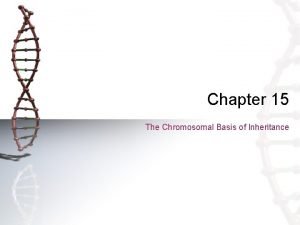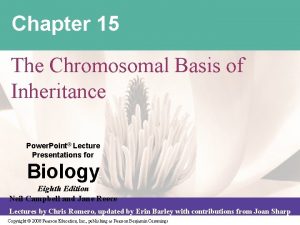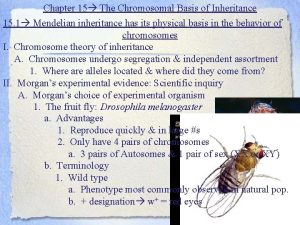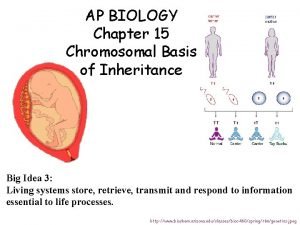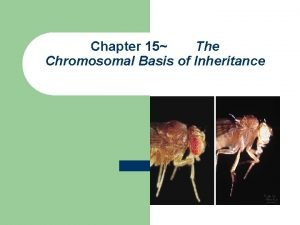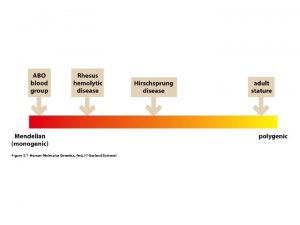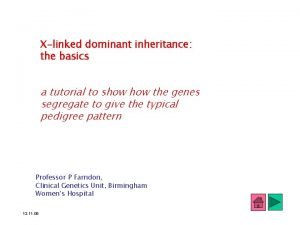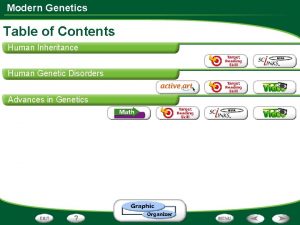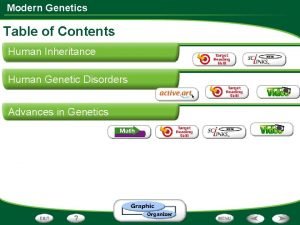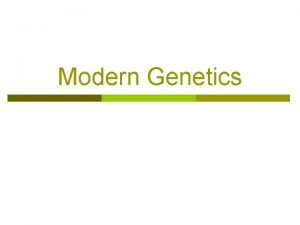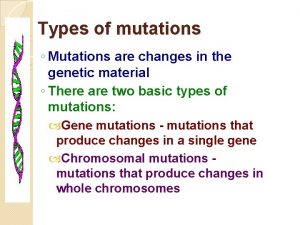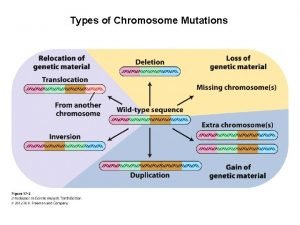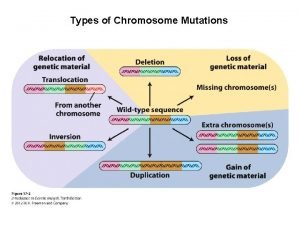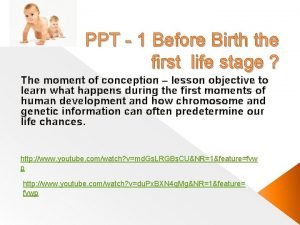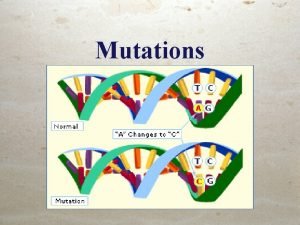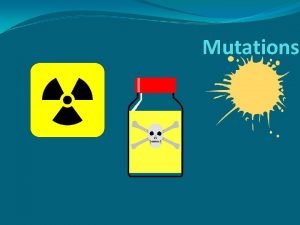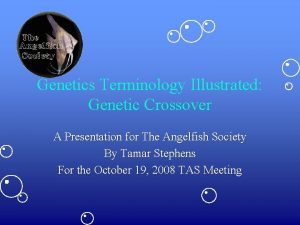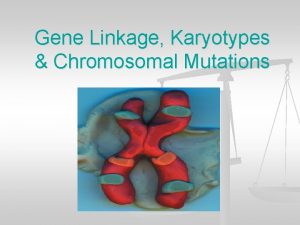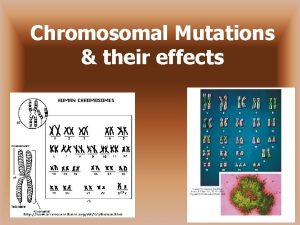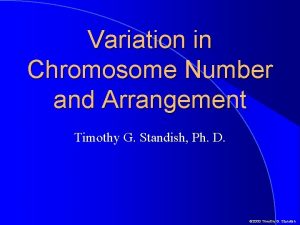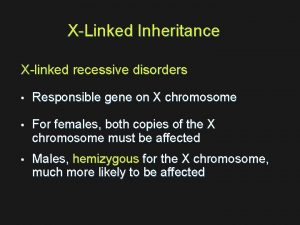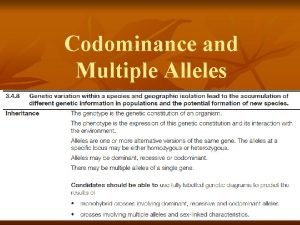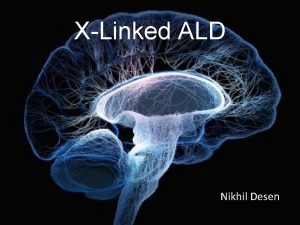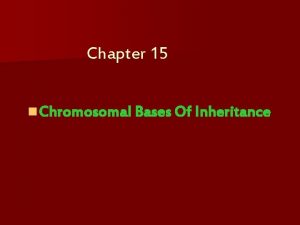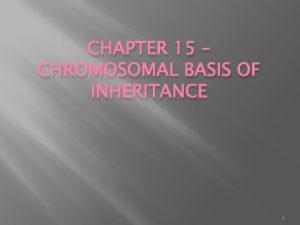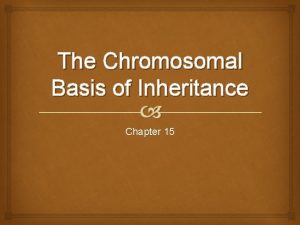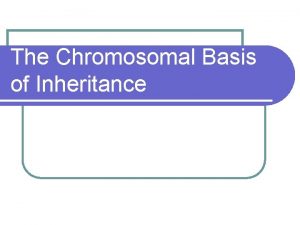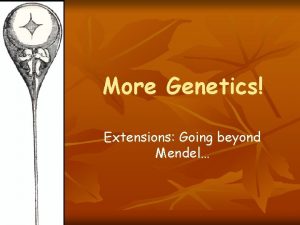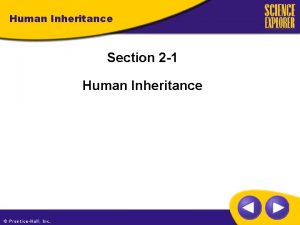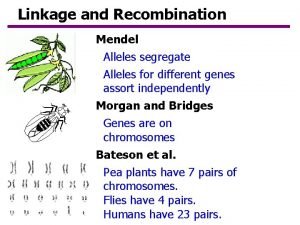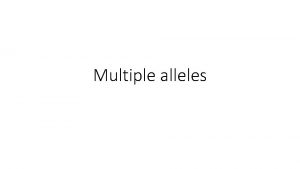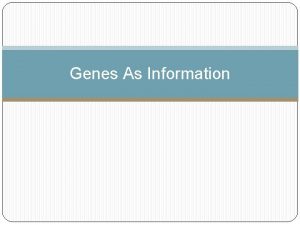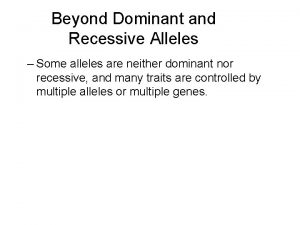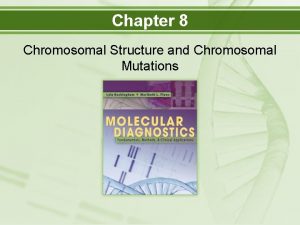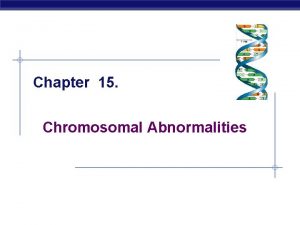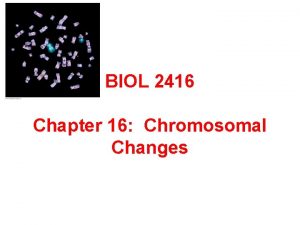Chapter 12 Chromosomal Inheritance Outline XLinked Alleles Human























- Slides: 23

Chapter 12 Chromosomal Inheritance

Outline X-Linked Alleles Human X-Linked Disorders Gene Linkage Crossing-Over Chromosome Map Changes in Chromosome Number Changes in Chromosome Structure Human Syndromes 2

Sex Determination in Humans Sex is determined in humans by allocation of chromosomes at fertilization Both sperm and egg carry one of each of the 22 autosomes The egg always carries the X chromosome as number 23 The sperm may carry either and X or Y If the sperm donates an X in fertilization, the zygote will be female If the sperm donates a Y in fertilization, the zygote will be male Therefore, the sex of all humans is determined by the sperm donated by their father 3

X-Linked Alleles Genes carried on autosomes are said to be autosomally linked Genes carried on the female sex chromosome (X) are said to be X linked (or sex linked) X linked genes have a different pattern of inheritance than autosomal genes have The Y chromosome is blank for these genes Recessive alleles on X chromosome: Follow familiar dominant/recessive rules in females (XX) Are always expressed in males (XY), whether dominant or recessive Males said to be monozygous for X linked genes 4

Eye Color in Fruit Flies Fruit flies (Drosophila melanogaster) are common subjects for genetics research They normally (wild-type) have red eyes A mutant recessive allele of a gene on the X chromosome can cause white eyes Possible combinations of genotype and phenotype: X RX R X RX r X r X RY X r. Y Genotype Homozygous Dominant Heterozygous Homozygous Recessive Monozygous Dominant Monozygous Recessive Phenotype Female Red-eyed Female White-eyed Male Red-eyed Male White-eyed 5

X-Linked Inheritance 6

Human X-Linked Disorders: Red-Green Color Blindness Color vision In humans: Depends three different classes of cone cells in the retina Only one type of pigment is present in each class of cone cell The gene for blue sensitive is autosomal The red sensitive and green sensitive genes are on the X chromosome Mutations in X linked genes cause RG color blindness: w All males with mutation (Xb. Y) are colorblind w Only homozygous mutant females (Xb. Xb) are colorblind w Heterozygous females (XBXb) are asymptomatic carriers 7

Red-Green Colorblindness Chart 8

X-Linked Recessive Pedigree 9

Human X-Linked Disorders: Muscular Dystrophy 10 Muscle cells operate by release and rapid sequestering of calcium Protein dystrophin required to keep calcium sequestered Dystrophin production depends on X-linked gene A defective allele (when unopposed) causes absence of dystrophin Allows calcium to leak into muscle cells Causes muscular dystrophy All sufferers male Defective gene always unopposed in males Males die before fathering potentially homozygous recessive daughters

11 Human X-Linked Disorders: Hemophilia “Bleeder’s Disease” Blood of affected person either refuses to clot or clots too slowly Hemophilia A – due to lack of clotting factor IX Hemophilia B – due to lack of clotting factor VIII Most victims male, receiving the defective allele from carrier mother Bleed to death from simple bruises, etc. Factor VIII now available via biotechnology

Hemophilia Pedigree 12

Human X-Linked Disorders: Fragile X Syndrome Due to base-triplet repeats in a gene on the X chromosome CGG repeated many times 6 -50 repeats – asymptomatic 230 -2, 000 repeats – growth distortions and mental retardation Inheritance pattern is complex and unpredictable 13

Gene Linkage When several genes of interest exist on the same chromosome Such genes form a linkage group Tend to be inherited as a block If all genes on same chromosome: Gametes of parent likely to have exact allele combination as gamete of either grandparent Independent assortment does not apply If all genes on separate chromosomes: Allele combinations of grandparent gametes will be shuffled in parental gametes Independent assortment working 14

15 Chromosome Number: Polyploidy Occurs when eukaryotes have more than 2 n chromosomes Named according to number of complete sets of chromosomes Major method of speciation in plants Diploid egg of one species joins with diploid pollen of another species Result is new tetraploid species that is self-fertile but isolated from both “parent” species Some estimate 47% of flowering plants are polyploids Often lethal in higher animals

Chromosome Number: Aneuploidy 16 Monosomy (2 n - 1) Diploid individual has only one of a particular chromosome Caused by failure of synapsed chromosomes to separate at Anaphase I (nondisjunction) Trisomy (2 n + 1) occurs when an individual has three of a particular type of chromosome Diploid individual has three of a particular chromosome Also caused by nondisjunction This usually produces one monosomic daughter cell and one trisomic daughter cell in meiosis I Down syndrome is trisomy 21

Nondisjunction 17

Chromosome Number: Abnormal Sex Chromosome Number Result of inheriting too many or too few X or Y chromosomes Caused by nondisjunction during oogenesis or spermatogenesis Turner Syndrome (XO) Female with single X chromosome Klinefelter Syndrome (XXY) No matter how many X chromosomes, presence of Y renders individual male 18

Chromosome Number: Abnormal Sex Chromosome Number Ploy-X females XXX simply taller & thinner than usual Some learning difficulties Many menstruate regularly and are fertile More than 3 Xs renders severe mental retardation Jacob’s syndrome (XYY) Tall, persistent acne, speech & reading problems 19

Abnormal Chromosome Structure Deletion Missing segment of chromosome Lost during breakage Translocation A segment from one chromosome moves to a non homologous chromosome Follows breakage of two nonhomologous chromosomes and improper re assembly 20

Deletion, Translocation, Duplication, and Inversion 21

22 Abnormal Chromosome Structure Duplication A segment of a chromosome is repeated in the same chromosome Inversion Occurs as a result of two breaks in a chromosome The internal segment is reversed before re-insertion Genes occur in reverse order in inverted segment

Abnormal Chromosome Structure Deletion Syndromes Williams syndrome - Loss of segment of chromosome 7 Cri du chat syndrome (cat’s cry) Loss of segment of chromosome 5 Translocations Alagille syndrome Some cancers 23
 Chapter 15: the chromosomal basis of inheritance
Chapter 15: the chromosomal basis of inheritance Chapter 15 the chromosomal basis of inheritance
Chapter 15 the chromosomal basis of inheritance The chromosomal basis of inheritance chapter 15
The chromosomal basis of inheritance chapter 15 Chapter 15 the chromosomal basis of inheritance
Chapter 15 the chromosomal basis of inheritance Chapter 15: the chromosomal basis of inheritance
Chapter 15: the chromosomal basis of inheritance Xlinked pedigree
Xlinked pedigree Vertical transmission
Vertical transmission Xlinked traits
Xlinked traits Chapter 11 complex inheritance and human heredity test
Chapter 11 complex inheritance and human heredity test Chapter 11 section 1 basic patterns of human inheritance
Chapter 11 section 1 basic patterns of human inheritance Chapter 11 section 1 basic patterns of human inheritance
Chapter 11 section 1 basic patterns of human inheritance Human inheritance modern genetics answer key
Human inheritance modern genetics answer key Modern genetics human inheritance answer key
Modern genetics human inheritance answer key Modern genetics human inheritance answer key
Modern genetics human inheritance answer key Syndrome triple x
Syndrome triple x Chromosomal mutation deletion
Chromosomal mutation deletion Deletion chromosomal mutation
Deletion chromosomal mutation Cri du chat chromosomal abnormalities
Cri du chat chromosomal abnormalities Mutations are any mistake or change in the...
Mutations are any mistake or change in the... What type of mutation is cri du chat syndrome
What type of mutation is cri du chat syndrome Chromosomal crossover
Chromosomal crossover Karyotype mutations
Karyotype mutations Karyotype mutations
Karyotype mutations Chromosome numbers
Chromosome numbers
